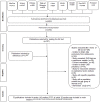Common mental disorders prevalence in adolescents: A systematic review and meta-analyses
- PMID: 32324835
- PMCID: PMC7179924
- DOI: 10.1371/journal.pone.0232007
Common mental disorders prevalence in adolescents: A systematic review and meta-analyses
Abstract
An increasing number of original studies suggest the relevance of assessing mental health; however, there has been a lack of knowledge about the magnitude of Common Mental Disorders (CMD) in adolescents worldwide. This study aimed to estimate the prevalence of CMD in adolescents, from the General Health Questionnaire (GHQ-12). Only studies composed by adolescents (10 to 19 years old) that evaluated the CMD prevalence according to the GHQ-12 were considered. The studies were searched in Medline, Embase, Scopus, Web of Science, Lilacs, Adolec, Google Scholar, PsycINFO and Proquest. In addition, the reference lists of relevant reports were screened to identify potentially eligible articles. Studies were selected by independent reviewers, who also extracted data and assessed risk of bias. Meta-analyses were performed to summarize the prevalence of CMD and estimate heterogeneity across studies. A total of 43 studies were included. Among studies that adopted the cut-off point of 3, the prevalence of CMD was 31.0% (CI 95% 28.0-34.0; I2 = 97.5%) and was more prevalent among girls. In studies that used the cut-off point of 4, the prevalence of CMD was 25.0% (CI 95% 19.0-32.0; I2 = 99.8%). Global prevalence of CMD in adolescents was 25.0% and 31.0%, using the GHQ cut-off point of 4 and 3, respectively. These results point to the need to include mental health as an important component of health in adolescence and to the need to include CMD screening as a first step in the prevention and control of mental disorders.
Conflict of interest statement
The authors have declared that no competing interests exist.
Figures




References
-
- World Health Organization; Depression and other common mental disorders: global health estimates WHO World Heal Organ; [Internet]. 2017;1–24. Available from: http://apps.who.int/iris/bitstream/10665/254610/1/WHO-MSD-MER-2017.2-eng...
-
- UNICEF. The United NAtions Childre´s Fund. Adolescence: A Time That Matters [Internet]. 2002. 7–44 p. Available from: www.unicef.org
-
- James SL, Abate D, Abate KH, Abay SM, Abbafati C, Abbasi N, et al. Global, regional, and national incidence, prevalence, and years lived with disability for 354 diseases and injuries for 195 countries and territories, 1990–2017: a systematic analysis for the Global Burden of Disease Study 2017. Lancet. 2018;392(10159):1789–858. 10.1016/S0140-6736(18)32279-7 - DOI - PMC - PubMed
Publication types
MeSH terms
LinkOut - more resources
Full Text Sources
Medical

